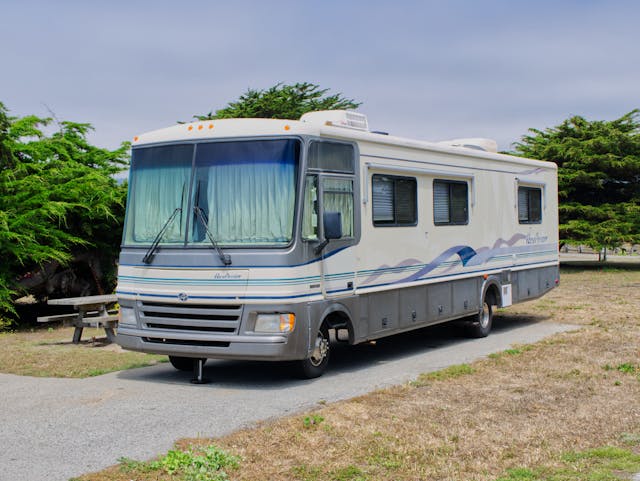While shopping for an RV, many wonder if a fifth wheel comes with a generator. The answer is yes, most fifth wheels do have a built-in generator. The critical question is whether the generator is powerful enough to meet your needs. Some people need a generator for basic functions, while others prefer to boondock and use multiple appliances such as air conditioners, microwaves, toasters, and televisions simultaneously. It’s important to remember that different appliances require varying amounts of power.
When browsing fifth wheels, be sure to evaluate the generator’s capacity. Most fifth wheels feature Onan generators housed in a compartment at the front near the hitch. For those requiring substantial power, a 50 amp generator is preferable over a 30 amp. If the fifth wheel only has a 30 amp generator, you might need to purchase an additional small generator.
Ensure that the built-in generator is capable of powering the entire fifth wheel. Manufacturers often cut corners with generator capacity. For instance, a 30 amp generator might suffice for a single air conditioner but won’t support additional appliances or dual air conditioners. Some people opt for two smaller generators since they are easier to transport, especially if you add gasoline after arriving at your destination. Look for dual-fuel generators for added versatility. Additionally, consider whether the model you’re looking at offers solar power to supplement your energy needs.
For fifth wheels with two air conditioners, it’s crucial to have a generator powerful enough to run both. Air conditioners require more power initially but less once they are running. Most 50 amp generators offer dual feeds, providing a total of 100 amps, whereas 30 amp generators typically have only one feed.
How to Determine Amp Hours
Figuring out your power needs requires a bit of detective work. You can usually find the necessary information for your appliances on the back, bottom, or online. Use the equation: watts divided by voltage equals amps. Remember to consider both obvious appliances like a coffee maker and less obvious ones like the blower on a propane furnace.
Additionally, using an inverter increases the power consumption, so you’ll need to account for that when calculating your needs. Once you’ve determined your power requirements, keep this information handy for future reference to save yourself from recalculating later.
A 50 amp service RV provides a maximum of 12,000 watts. Even with an adapter, a 30 amp service RV won’t handle more than its 3,600-watt capacity. This will help you decide whether the built-in generator, typically an Onan, is sufficient or if you’ll need to purchase a second generator.
Is an Inverter Needed?
Many fifth wheels come equipped with both an inverter and a generator. Instead of searching for the perfect fifth wheel that includes all the desired equipment, it might be more practical to find a model that suits your family’s needs and upgrade the equipment as necessary. If you decide to invest in an inverter, many recommend choosing a pure sine wave inverter. While they may be more expensive upfront, typically costing between $200 and $400, they generally offer better performance.
Reducing Generator Noise Levels
The first concern with generators is whether they are powerful enough to meet your needs. The second common question is about the noise level of the Onan generator, especially since it is built into the fifth wheel and cannot be moved away. Fortunately, resonators can be purchased and installed to reduce the noise level of the generator. These cost around fifty dollars. Ensure you check what other items might be needed with the resonator you purchase, such as a clamp. Depending on the resonator and the model of the generator in your fifth wheel, it could reduce the noise level by up to one dB(A). There are other noise-reducing solutions available, but make sure they are safe and do not void your warranty.
If you find it necessary to buy an additional generator to supplement your built-in one, you can place the portable generator at a distance from the fifth wheel to reduce the noise. Many camping enthusiasts recommend Honda generators for their quiet operation. These generators typically weigh around 45 lbs., depending on the model, and can range in price from $999.00 on Amazon to $2,199.00 at Max Tool.
Solar Energy
While many fifth wheels come either solar-prepped or with solar energy included, enthusiasts agree that going solar isn’t for everyone. Rather than being just another energy source, it represents a lifestyle change. Additionally, many campers are unaware of what solar energy can and cannot do. Solar energy might power a microwave, but it won’t run an air conditioner, let alone a dual air conditioner setup.
Similar to how some manufacturers may skimp on generator capacity, the wiring installed in fifth wheels for solar energy often needs replacement by mechanics, as even the wiring in late-model fifth wheels may be inadequate and pose a fire risk. Before deciding to forgo a generator, make sure you thoroughly understand the capabilities and limitations of solar energy.
Preventing Carbon Monoxide and Electric Shock Hazards
Using generators safely is a serious concern. Generators emit carbon monoxide, a colorless and odorless gas that can build up without warning, posing a significant risk to you and your family. Many fifth wheels come with carbon monoxide detectors; ensure these have fresh batteries. If your fifth wheel lacks detectors, purchase and install several immediately.
Never assume the absence of carbon monoxide fumes just because you haven’t experienced problems before; fumes can accumulate slowly and become deadly. For portable generators, position them as far away from your fifth wheel as possible, ensuring the exhaust faces away from doors and windows. Avoid placing the generator under your awning, even during rain, as this can expose you to carbon monoxide. Instead, use a canopy to shield the generator from rain at a safe distance.
Consider purchasing a generator tent, like a GenTent, to keep your portable generator dry. These can be found online for a couple of hundred dollars at GenTent. Rain can damage portable generators and create risks of electrocution and serious shock. Always place your generator on a dry surface and ensure power cords are not lying in standing water or on wet ground.
Essential Safety Features
When purchasing your generator, ensure it has GFCI (ground fault circuit interrupt) outlets. These outlets automatically shut off if they get wet or detect an electrical leak, preventing dangerous shocks. If your portable generator shuts off unexpectedly, do not approach it. Instead, contact the manufacturer for guidance. Prioritizing safety is always more important than convenience.
How to Determine If a Second Generator is Needed
If you’re unsure whether you’ll need an additional generator, consider spending a night in your fifth wheel at home before your camping trip. This trial run can provide valuable insights beyond what calculations can tell you. Stick to your usual routine: if you use a blow dryer in the morning, use it during the trial run. Make your coffee with the coffeemaker. This practice will help you determine if a second generator is necessary.
As the industry evolves, more energy sources become available to power an RV, at least partially. Many campers still prefer generators, sometimes supplemented with solar power. Ultimately, the choice is individual, and there’s no right or wrong answer. Choose the method that best meets your energy needs and makes you and your family happy while camping. Often, a combination of power sources can be the most effective solution.

